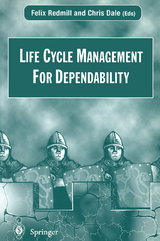Life Cycle Management For Dependability
Springer Berlin (Verlag)
978-3-540-76073-3 (ISBN)
1 This Business of Dependability.- 1.1 Introduction.- 1.2 Defining Dependability.- 1.3 Users' and Society's Needs for Dependable Systems.- 1.4 Some Failures of Systems Which Should Have Been Dependable.- 1.5 Achieving and Assessing Dependability.- 2 Getting the Culture Right.- 2.1 Introduction.- 2.2 Factors Affecting Organisational Performance.- 2.3 So What is Culture?.- 2.4 Characteristics of a Dependability Culture.- 2.5 What Happens if We Get It Wrong?.- 2.6 Developing the Right Culture.- 2.7 Final Remarks.- 3 Policy and Planning for Dependability.- 3.1 Introduction.- 3.2 Definitions.- 3.3 Compilation and Presentation.- 3.4 General Contents.- 3.5 Specific Content for Individual Life-cycle Phases.- 3.6 Summary.- 4 Measurement and Assurance.- 4.1 Introduction.- 4.2 Software Project Management and Management Challenges.- 4.3 Simple Process Measures.- 4.4 Refining the Measures.- 4.5 Best Practice.- 4.6 Use of the Measures.- 4.7 Assurance.- 4.8 Conclusions.- 5 Third Generation Project Management.- 5.1 The Challenge for Project Management.- 5.2 What is Project Success?.- 5.3 What Makes Projects Fail?.- 5.4 The Essential Elements of Project Management.- 5.5 The Characteristics of Successful Managers.- 5.6 A Final Note.- 6 Operations Management for Dependability.- 6.1 Introduction.- 6.2 Trends in Computer-related Systems.- 6.3 Incidents and Insights into Dependability.- 6.4 Organisational Structure, Management and Competence.- 6.5 Documentation, Including Operating Instructions.- 6.6 Contingency Planning.- 6.7 Security and Access Control.- 6.8 Hand-over Approval for Live Operation.- 6.9 Training.- 6.10 Preventative Maintenance and Calibration.- 6.11 Repair, Modification and Change Control.- 6.12 Reviewing Operations.- 6.13 Decommissioning from Live Operation.- 6.14Regulation.- 6.15 Lessons and the Future.- 7 Managing Maintenance and Change.- 7.1 Introduction.- 7.2 Some Principles.- 7.3 Levels of Approval.- 7.4 Management Responsibilities.- 7.5 The Maintenance Cycle - The Maintenance and Modification Management Model.- 7.6 Revalidation and Configuration Management.- 7.7 Maintenance of System Architectures for Dependability.- 7.8 Engineering Aspects.- 8 Practical Risk Management.- 8.1 Introduction.- 8.2 What is Risk?.- 8.3 Risk Management Goals.- 8.4 Uncertainty and Risk.- 8.5 A Simple Approach.- 8.6 The Management of Risk.- 8.7 Tolerable Risk and the 'ALARP' Principle.- 8.8 A Simple Tool for Risk Analysis.- 8.9 Action Plans Against Risk.- 8.10 Beware of Underestimating Risk - Three Laws.- 8.11 Final Remarks.- References.
| Erscheint lt. Verlag | 18.4.1997 |
|---|---|
| Vorwort | T. Anderson |
| Zusatzinfo | XVIII, 235 p. 5 illus. |
| Verlagsort | London |
| Sprache | englisch |
| Maße | 155 x 235 mm |
| Gewicht | 400 g |
| Themenwelt | Mathematik / Informatik ► Informatik ► Betriebssysteme / Server |
| Mathematik / Informatik ► Informatik ► Software Entwicklung | |
| Mathematik / Informatik ► Informatik ► Theorie / Studium | |
| Informatik ► Weitere Themen ► Hardware | |
| Technik | |
| Schlagworte | Configuration Management • Design • Industrie • language • Maintenance • Management • Mathematics • Model • organization • Planning • Project Management • Repair • Risk Management • Software • Validation |
| ISBN-10 | 3-540-76073-3 / 3540760733 |
| ISBN-13 | 978-3-540-76073-3 / 9783540760733 |
| Zustand | Neuware |
| Haben Sie eine Frage zum Produkt? |
aus dem Bereich




